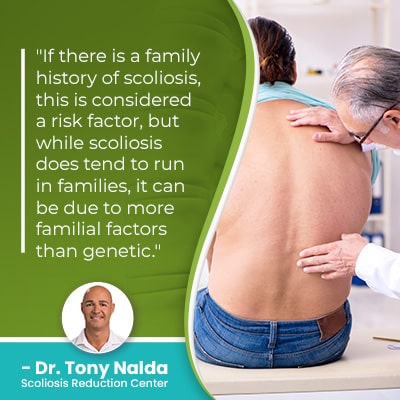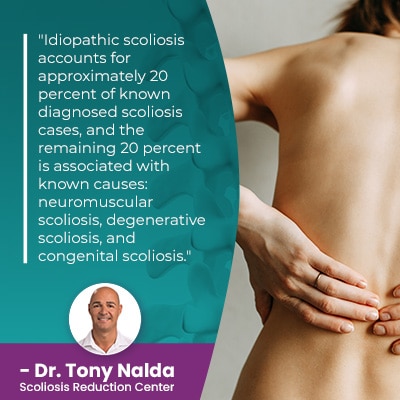Scoliosis Causes: Is Scoliosis Hereditary, Genetic, or Other?

When it comes to understanding the etiology of scoliosis, condition-type is a key factor. The most common type of scoliosis to affect children and adults is classified as idiopathic, meaning we don't fully understand what causes the condition to develop, but there are other forms of scoliosis associated with clear causes; continue reading to understand the difference.
As efforts to isolate a specific gene, or genetic mutation, to account for the development of idiopathic scoliosis has yet to be isolated, scoliosis is more accurately described as familial than genetic. There are also less-prevalent forms of scoliosis with known causes.
While exploring the difference between a familial and a genetic condition, let's also address the different types of scoliosis because they have different underlying causes.
Table of Contents
The Underlying Causes of Scoliosis
When it comes to understanding the root causes of scoliosis, it's important to understand the different types of scoliosis, each with its own unique causation.
In addition to there being multiple different forms of scoliosis, there are also wide-ranging severity levels, and severity is determined by a measurement known as Cobb angle; the higher the Cobb angle, the more severe the condition is:
- Mild scoliosis: Cobb angle measurement of between 10 and 25 degrees
- Moderate scoliosis: Cobb angle measurement of between 25 and 40 degrees
- Severe scoliosis: Cobb angle measurement of 40+ degrees
- Very-severe scoliosis: Cobb angle measurement of 80+ degrees
When scoliosis is diagnosed, it means an unnatural sideways spinal curvature, with rotation, has developed, and this means the spine has become misaligned.
When the spine's natural and healthy curves are in place, its vertebrae (bones of the spine) are aligned, keeping the spine in a straight and neutral position, but when they become tilted due the development of an unhealthy curve, this disrupts the biomechanics of the entire spine.
In addition, all types of scoliosis are progressive, meaning the condition's nature is to worsen over time, especially if left untreated.
Regardless of type, proactive treatment is key to counteracting the condition's progressive nature.
So let's start exploring the different types of scoliosis as they are associated with different causes, starting with the most common, idiopathic, and addressing whether or not it's considered to be caused by genetic factors.
Idiopathic Scoliosis
Idiopathic scoliosis is the most common type to affect both children and adults.
The most prevalent form of scoliosis, overall, is adolescent idiopathic scoliosis (AIS), diagnosed between the ages of 10 and 18, and idiopathic scoliosis in adults are cases of AIS that were undiagnosed and untreated during adolescence.
Idiopathic means we don't fully understand the condition's cause, but this isn't the same as not having a cause at all; idiopathic scoliosis is thought to be more multifactorial, meaning caused by a combination of factors that can vary from person to person.
Is Scoliosis Hereditary?
If a condition is caused by hereditary factors, also known as a genetic predisposition, this means the condition develops because of a specific scoliosis gene, genetic defect, and/or defective genes, and that gene can be passed down from one generation to the next.
Now, scoliosis is a highly-prevalent spinal condition with current estimates at close to 7 million people currently living with the condition in the United States alone, and as the leading spinal condition amongst school-aged children, an extensive amount of research has been conducted on the subject of causation.
I think it's fair to say that if there was a single gene, or genetic mutation, that explained the development of idiopathic scoliosis, it would have been identified by now.
On the flip side, what about the fact that a person's chance of being diagnosed with scoliosis increases if the condition is in the family?
This is where the difference between genetic and familial is important, and as researchers suspect a person's likelihood of developing scoliosis increases if there is a family history of the condition, what other factors do families share, other than genetics?
Family members share a lot more than just their genes: socioeconomic factors, geographical factors, common responses to stress, posture, shared diet and lifestyle factors, etc.
 If there is a family history of scoliosis, this is considered a risk factor, but while scoliosis does tend to run in families, it can be due to more familial factors than genetic.
If there is a family history of scoliosis, this is considered a risk factor, but while scoliosis does tend to run in families, it can be due to more familial factors than genetic.
Furthermore, twin studies show that even in identical twins who share the same genetic factors, one identical twin can develop scoliosis, while the other does not, or one twin can develop a particular type of scoliosis curve, while the other twin develops a completely different unnatural curvature of the spine/severity level.
In the end, there is no clear answer, speaking to the need for more genetic research; idiopathic scoliosis twin studies research suggests that the condition could be caused by a combination of genetic and environmental factors.
So while it's possible that there's a genetic predisposition to idiopathic scoliosis development, a clear genetic link has yet to be identified.
If indeed a specific scoliosis gene exists, it's possible that a person can carry it without developing the condition, and conversely, a person who doesn't carry the gene can develop scoliosis due to a number of different factors (multifactorial).
As scoliosis runs in families, the topic of whether or not scoliosis is genetic is a controversial one, and I have to think that considering scoliosis has been around since ancient times, its prevalence, and the extensive research done, if a scoliosis gene existed, it would have been identified by now.
Now, as mentioned earlier, while idiopathic scoliosis is the most prevalent, there are also other condition types that are associated with known causes, so let's briefly address those.
Scoliosis with Known Causes
 Idiopathic scoliosis accounts for approximately 20 percent of known diagnosed scoliosis cases, and the remaining 20 percent is associated with known causes: neuromuscular scoliosis, degenerative scoliosis, and congenital scoliosis.
Idiopathic scoliosis accounts for approximately 20 percent of known diagnosed scoliosis cases, and the remaining 20 percent is associated with known causes: neuromuscular scoliosis, degenerative scoliosis, and congenital scoliosis.
Neuromuscular Scoliosis Causation
In neuromuscular scoliosis (NMS) patients, the scoliosis has developed due to the presence of a larger neuromuscular condition such as muscular dystrophy, spina bifida, or cerebral palsy, to name a few.
Neuromuscular conditions involve a disconnect between the brain and the muscles/connective tissues that support the spine.
While not everyone with a neuromuscular condition will develop scoliosis, it is a common complication, and while there is a genetic component to a number of neuromuscular conditions, neuromuscular scoliosis itself isn't generally considered a genetic condition because the scoliosis has developed as a secondary complication.
Degenerative Scoliosis
Degenerative scoliosis patients are usually over the age of 40 as the condition's main cause is natural age-related spinal degeneration.
As the spine starts to degenerate, this often involves the intervertebral discs, and deterioration disrupts the spine's ability to maintain its natural curves/alignment; in addition, the cumulative effect of certain lifestyle factors can also play a role.
So degenerative scoliosis cases are not generally considered genetic because it's the spine's degenerative changes that lead to the development of degenerative scoliosis, not genetic factors.
Congenital Scoliosis
Congenital scoliosis patients are infants that are born with the condition due to a malformation within the spine itself that developed in utero.
Oftentimes, one or more vertebrae (bones of the spine) will be misshapen, causing the development of an unnatural spinal curve, and vertebrae can also fail to separate into distinct vertebral bodies, instead becoming fused together as one bone, causing the bones to form a wedge that shifts the spine out of alignment.
Research results are mixed on the subject of congenital scoliosis etiology, revealing links to both genetic and environmental factors.
Conclusion
For patients recently diagnosed with adolescent idiopathic scoliosis, it's natural to seek understanding of why the condition developed, and many people look to genetics for an answer.
While there are genetic risk factors if another person in the family has scoliosis, strong evidence suggests that the connection is more familial than genetic; remember, families share a lot more than just their genes.
Here at the Scoliosis Reduction Center, I remind patients, and their families, that while it can be difficult to hear that we don't know why a child has developed adolescent idiopathic scoliosis, that knowledge wouldn't necessarily change the course of treatment, or its outcome; in terms of treatment efficacy, what's most important is how a diagnosis is responded to.
Once scoliosis has developed and is diagnosed, the reality is that regardless of its cause, it needs to be addressed with proactive treatment that works towards counteracting the condition's progressive nature.
Regardless of condition type, severity, or cause, the most important decision involves how to respond to the condition's presence, and while scoliosis is progressive and incurable, it is highly treatable, particularly with early detection and proactive conservative treatment.
Dr. Tony Nalda
DOCTOR OF CHIROPRACTIC
After receiving an undergraduate degree in psychology and his Doctorate of Chiropractic from Life University, Dr. Nalda settled in Celebration, Florida and proceeded to build one of Central Florida’s most successful chiropractic clinics.
His experience with patients suffering from scoliosis, and the confusion and frustration they faced, led him to seek a specialty in scoliosis care. In 2006 he completed his Intensive Care Certification from CLEAR Institute, a leading scoliosis educational and certification center.
About Dr. Tony Nalda
 Ready to explore scoliosis treatment? Contact Us Now
Ready to explore scoliosis treatment? Contact Us Now





